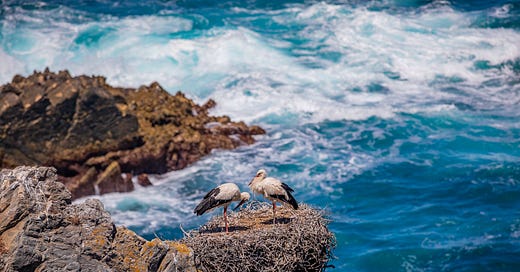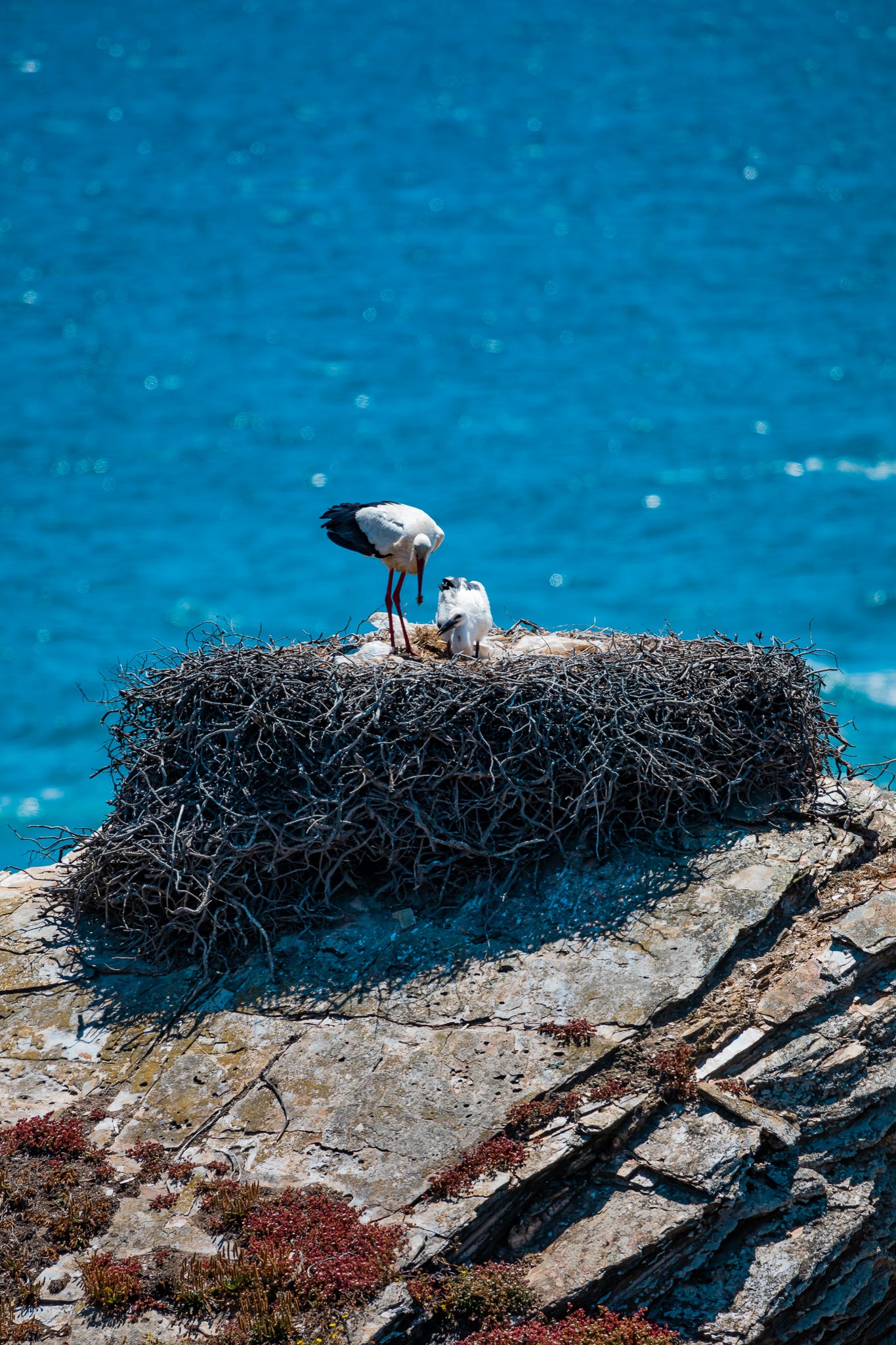The white stork, climate change, and The Long Ways: Exploring curiosity sparked by trails around the world
Chasing curiosity one trail at a time.
One of the most unexpected things about hiking a long trail is just how curious it can make you.
While hiking along the Atlantic coast of Portugal in 2022 - a route known as the Fisherman’s Way, part of a the much longer Rota Vicentina trail - we spied several massive, five-foot wide nests precariously balanced on the edges of pillars of rock rising out from the sea. These nests were particularly widespread near the Cape Sardao Lighthouse, not far from the town of Zambujeira do Mar.
Take a good set of binoculars - or a telephoto camera lens - and you can clearly spot dozens of large white birds taking off and landing from these pillars. In summer, you may even catch a glimpse of one or two small and still flightless chicks, tiny white specks against the ocean. In Portugal, these birds are known as Cegonha branca — “white storks.”
As the miles went by on our hike, we found ourselves asking: why are they even up there in the first place?
Copyright: Eric Weber with Inspire EdVentures.
It’s small moments of curiosity like this that stand out across our mission to hike the great long trails of the world. Along the Lycian Way in Turkey, for instance, we found a gate dedicated to the Roman emperor Hadrian — thousands of miles from the his eponymous wall in Scotland, which one of our trio had hiked along just months before. In Slovenia, we ate lunch on the steps of an old WW1 field hospital, and gazed out over serene mountains once bitterly fought between Austria and Italy in the depths of winter. And in Ireland, we walked through one of the few remaining Gaeltachts, places where Irish remains the first language after centuries of fading away under English rule.
Stop by these sites in a car or guided tour, and these places might be passing curiosities. But walk, step by step and day by day, along a road initially built for Roman soldiers, or traverse a series of footpaths used by shepherds for thousands of years, and you can find that the sense of place, the weight of the history you’re walking through becomes more profound. Inevitably, questions - why is this the case, who built this and why, what lives called this place home- arise. (The hours spent in your own head, often without a cellphone signal, doesn’t hurt, either.)
In short, you get curious.
What is The Long Ways?
For the past seven years, our hiking trio - journalist Devin, science educator and author Mike, and photographer Eric - have been out to hike the great long trails of the world. What started off as a last-minute (and ill-prepared) tour around Mont Blanc in France has seen us since hike across Ireland and Scotland, walk along the coasts of Turkey and Portugal, and ascend the Julian Alps of Slovenia. Over the years, we’ve traversed stunning mountain ridges, been drenched in in days-long rainstorms, learned how to (poorly) say thank you in six languages, and learned a lot about ourselves and the world — all one step along the trail at a time.
We’ve been talking about these hikes through our podcast, the Long Ways Podcast, over the last two years. Today, we’re expanding to Substack to go more in-depth about these moments of curiosity. Why is there a south pole themed bar in a small town in Ireland? Why came the emperor Hadrian’s name be found today in ruins from Scotland to Turkey? And what the hell is up with those storks, anyways?
On the third Friday of each month, our Substack will bring you a story from the trail that sparked out curiosity. We’re not giving up on our podcast, either, but we are doing something different with it: each month, we’re stepping outside of our own experiences by talking with a different person on a trail that mattered to them. You can find our latest episode below.
Ultimately, we’re looking to share with your our deep curiosity about the world and to inspire you, our reader. We believe deeply that the treks we do each year aren’t just opportunities to see a pretty view or drink a well-earned beer in a new place (though those are definitely pluses!) - they’re opportunities to see the world differently, to travel off the crowded tourist tracks, and to engage fully with the culture, history and food of a given country and its people while pushing ourselves outside of our comfort zone to try something difficult or experience somewhere new.
Interested in being a part of this community? You can start by subscribing below:
The white storks of Portugal
But back to the storks: why are they up on those pinnacles of rock?
A few facts we learned: white storks are migratory birds — they spend the breeding season in Portugal and Spain, before crossing the Straights of Gibraltar to winter south of the Sahara each year. They often return to the same nest year after year, even going so far as to build back from scratch a nest lost in a winter storm.
But these rocky outcrops aren’t the only places they nest. On the contrary, all across Portugal and Spain, you can find storks nesting on chimneys, telephone poles and more. In fact, in the storks’ entire range, it’s only along this specific coast of Portugal that they choose to nest out at sea.
This isn’t the most pleasant place to nest, either — the Atlantic Ocean here is cold even in summer, with huge breaking waves and howling winds (we almost lost a few hats along our hike). We definitely wouldn’t want to be caught out on these cliffs in a storm.
But as so often is the case these days, there might be a climate change element to this story. As the world heats up, Portugal is having much milder winters, and some storks are choosing to stay as a result. We weren’t able to fact check this, but we heard that they have only begun nesting out to sea has been relatively recently, perhaps in the last twenty years or so - in parallel with warming weather across Europe.
As more storks stay year round, prime nesting sites could be growing more scarce. It’s possible that some might choose to go out to sea, as a result. This isn’t the only way climate change is impacting storks: another population that migrates between Poland and Africa is moving ever further north (as far as Finland!) along with warming temperatures.
Not that the storks seem to care: while we humans are scratching our heads on why they’re up there on those rocky chimneys, they seem for now quite content raising a new generation of chicks each year in the middle of the Atlantic ocean.
We think climate change might have a role, but this is only a hypothesis. Do you know what’s behind these storks nesting out to sea? If so, drop us a comment below!
If you’ve seen the white storks yourself, post a photo on Instagram and tag us!
Copyright: Eric Weber with Inspire EdVentures.
Latest podcast: The Inca Trail
We’re doing something different this year: each month, we’re speaking to a new person on a trail that mattered to them, and why.
Last December, our most recent guest, Kayla, hiked the Inca Trail to Machu Picchu. She’ll be the first to say she’s not a long distance hiker – or even that she’d do it again. But she also spoke to us about the weight of history that comes with walking on the same paths tread by generations of people, why it's important to “embrace the suck,” and gave advice for others looking to hike it too.
Give it a listen:
Keep up to date
How can you continue to follow us?
First off, subscribe below! We’re enthusiastic of forming a community of hikers, travelers, and those curious about the world. Share the link with your friends and family, and keep an eye out for our next newsletter on March 13.
You can also follow us on our podcast by subscribing on Apple Podcast or Spotify. Follow us on Instagram for more real-time updates, especially live from the trail (this year, we’ll return to Scotland to hike the Great Glen Way across the Scottish Highlands).
Finally, consider following our sister organization, Inspire EdVentures, as it develops innovative ways of bring science education to learners of all ages.






Love it! I look forward to more.